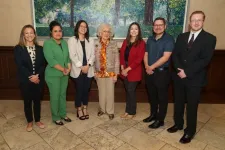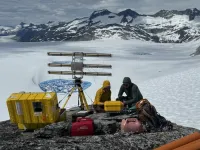(Press-News.org) The magnitude 4.8 Tewksbury earthquake surprised millions of people on the U.S. East Coast who felt the shaking from this largest instrumentally recorded earthquake in New Jersey since 1900.
But researchers noted something else unusual about the earthquake: why did so many people 40 miles away in New York City report strong shaking, while damage near the earthquake’s epicenter appeared minimal?
In a paper published in The Seismic Record, YoungHee Kim of Seoul National University and colleagues show how the earthquake’s rupture direction may have affected who felt the strongest shaking on 5 April.
Kim and her colleague and co-author Won-Young Kim of Lamont-Doherty Earth Observatory of Columbia University became curious about the strange pattern of shaking after visiting the epicenter area of the earthquake just eight hours after the mainshock.
“We expected some property damages—chimneys knocked down, walls cracked or plasters fallen to the ground—but there were no obvious signs of property damages,” the researchers said in an email. “Police officers within a couple of kilometers from the reported epicenter calmly talked about the shaking from the mainshock. It was a surprising response by the people and houses for a magnitude 4.8 earthquake in the region.”
“This contrasted with the wide and huge response from the residents in and around the New York City area, some 65 kilometers from the epicenter,” they added.
The earthquake garnered more than 180,000 felt reports—the largest number ever for a single earthquake received by the U.S. Geological Survey’s “Did You Feel It?” app and website, according to a second paper published in The Seismic Record by USGS seismologist Oliver Boyd and colleagues.
Boyd and colleagues said the earthquake was felt by an estimated 42 million people between Virginia and Maine.
The reports from people southwest of the epicenter, toward Washington, D.C., indicated “weak” shaking on the scale that the USGS uses to measure an earthquake’s intensity, while people reporting from northeast of the epicenter felt “light to moderate” shaking.
Based on previous models of magnitude and earthquake intensity developed for the eastern U.S., however, a magnitude 4.8 earthquake should produce very strong shaking within about 10 kilometers or about six miles from its epicenter.
With this pattern in mind, Kim and colleagues wanted to look closer at the directivity of the earthquake’s rupture. To model the rupture, they turned to a kind of seismic wave called Lg waves, due to the lack of nearby seismic observation at the time of the mainshock. Lg waves are shear waves that bounce back and forth within the crust between the Earth’s surface and the boundary between the crust and mantle.
The resulting model indicated the earthquake rupture had propagated toward the east-northeast and down on an east-dipping fault plane. The direction of the rupture might have funneled the earthquake’s shaking away from its epicenter and toward the northeast, the researchers concluded.
In general, earthquakes in the northeastern U.S. take place as thrust faulting along north-south trending faults. The New Jersey earthquake is unusual, Kim and colleagues noted, because it appears to have been a combination of a thrust and strike-slip mechanism along a possible north-northeast trending fault plane.
“Earthquakes in the eastern North America usually occur along the pre-existing zone of weakness—that is, existing faults,” the researchers explained. “In the Tewksbury area, a hidden fault plane trending north-northeast and dipping moderately can be mapped from the numerous small aftershocks detected and located” after the Tewksbury mainshock.
Boyd and colleagues noted that some damage was documented by a reconnaissance team deployed by the Geotechnical Extreme Events Reconnaissance Association and the National Institute of Standards and Technology. Along with cracks in drywall and objects falling from shelves, the team documented the partial collapse of the stone façade of Taylor’s Mill, a pre-Revolutionary War structure near the town of Lebanon, New Jersey.
The researchers have not yet attributed the earthquake to a particular fault but the locations of the mainshock and aftershocks suggest that the area’s well-known Ramapo fault system was not active during the earthquake.
The findings could “help us identify new earthquake sources and rethink how stress and strain are being accommodated in the eastern United States,” Boyd said.
He noted that some seismometers that were rapidly deployed to the region by the USGS will remain in place for at least five months.
“This can help us study, for example, mechanisms related to how the crust responds to the stress of a mainshock in the region, and how productive aftershock sequences can be in the eastern United States,” Boyd explained.
“Good station coverage can also allow us to observe how earthquake ground motions vary across the region as a function of magnitude, epicentral distance, and Earth structure. And each of these examples can help us better appreciate potential seismic hazards.”
END
Closer look at New Jersey earthquake rupture could explain shaking reports
2024-10-01
ELSE PRESS RELEASES FROM THIS DATE:
Researchers illuminate inner workings of new-age soft semiconductors
2024-10-01
One of the more promising classes of materials for next-generation batteries and electronic devices are the organic mixed ionic-electronic conductors, OMIECs for short. These soft, flexible polymer semiconductors have promising electrochemical qualities, but little is known about their molecular microstructure and how electrons move through them – an important knowledge gap that will need to be addressed to bring OMIECs to market.
To fill that void, materials scientists at Stanford recently employed ...
University of Houston partners with Harris County to create a sustainable energy future
2024-10-01
University of Houston researchers are partnering with the Harris County Office of County Administration’s Sustainability Office, the Harris County Energy Management Team and other county staff to develop a comprehensive baseline of energy use and energy-use intensity for county’s assets. Once established, the baseline will enable the team to track progress and evaluate the effectiveness of energy-saving measures over time, laying the groundwork for programs aimed at reducing energy consumption, maximizing savings, and increasing the use of renewable and resilient ...
Looking deeper into the mirror
2024-10-01
A team of Canadian and American scientists has made a promising breakthrough in understanding the origins of a mysterious neurological disorder known as mirror movements.
The discovery was made by Kaiyue Zhang, a doctoral student at the Montreal Clinical Research Institute (IRCM), affiliated with Université de Montréal, and by Karina Chaudhari, a doctoral student at the University of Pennsylvania.
As co-first authors, they published their study today in the journal Science Signaling.
They were led by Frédéric Charron, an UdeM research professor ...
Friends of BrainHealth donor circle awards coveted grants to fuel innovative research
2024-10-01
The 2024 Ramona Jones Friends of BrainHealth Luncheon on September 30, 2024 continued the 25th anniversary celebration of Center for BrainHealth – part of The University of Texas at Dallas – and the second year this annual event has been sponsored by founding Advisory Board member Ramona Jones and her family.
Staged “Shark Tank”-style” at the Dallas Country Club, the event featured a competition between emerging scientists pitching novel research proposals and vying for $20,000 in seed funding. Event co-chair Nikki Kapioltas opened the event, calling attention to a milestone ...
Study of infertility, health among women of Mexican heritage funded by $2.2M NIH grant
2024-10-01
Researchers at the University of Arizona Health Sciences and the Instituto Nacional de Salud Pública in Mexico are using a $2.2 million National Institutes of Health grant to explore the link between infertility and long-term health issues among Hispanic women of Mexican heritage.
According to recent research, female infertility is often associated with greater risks of cancer, cardiovascular disease and premature mortality. Hispanic women are up to 70% more likely to experience infertility than white women, yet little is known about their long-term health.
“Hispanics are the largest minority group in the United States, and 60% of Hispanics have Mexican heritage. ...
Airborne plastic chemical levels shock researchers
2024-10-01
A new study documents how Southern Californians are chronically being exposed to toxic airborne chemicals called plasticizers, including one that’s been banned from children’s items and beauty products.
Plasticizers are chemical compounds that make materials more flexible. They are used in a wide variety of products ranging from lunchboxes and shower curtains to garden hoses and upholstery.
“It’s not just for drinking straws and grocery bags,” said David Volz, environmental sciences professor at UC Riverside, ...
DOD awards $9M for snowpack and meltwater research and Arctic training program in Alaska and New England
2024-10-01
The Department of Defense (DOD) has awarded a $9 million contract to the University of Maine for research that will significantly expand efforts to quantify snowpack properties, explore the impact of snowmelt on the surrounding terrestrial environments of Alaska and Maine, and expand training opportunities in polar science.
The project is led by School of Earth and Climate Sciences and Climate Change Institute faculty member Seth Campbell, who will collaborate with more than a dozen other scientists from UMaine and other institutions. The effort builds on a related and existing ...
SETI Institute awards education grant through the STRIDE program
2024-10-01
SETI Institute Awards Education Grant through the STRIDE Program
October 1, 2024, Mountain View, CA – The SETI Institute awarded its first education grant through its Support Technology, Research, Innovation, Development and Education (STRIDE) program. The grant supports a new project called Encountering Stars in an Inflatable Planetarium, which will offer immersive astronomy and astrobiology experiences for elementary and middle school students in low-income areas and high school and adult audiences interested in STEM-related experiences. The program also includes a training workshop for K-12 teachers ...
NYU Historian Jennifer L. Morgan wins 2024 MacArthur “Genius Grant”
2024-10-01
New York University historian Jennifer L. Morgan, whose work focuses on the institutionalization of race-based slavery in early America and the Black Atlantic, has been named a 2024 MacArthur Fellow by the John D. and Catherine T. MacArthur Foundation.
MacArthur Fellows are recipients of the foundation’s “genius grants,” who each receive $800,000 over a five-year period to pursue intellectual, social, and artistic endeavors.
“The 2024 MacArthur Fellows pursue rigorous inquiry with aspiration and purpose,” says MacArthur Fellows Director ...
Research in 4 continents links outdoor air pollution to differences in children’s brains
2024-10-01
Outdoor air pollution from power plants, fires and cars continues to degrade human, animal and environmental health around the globe. New research shows that even pollution levels that are below government air-quality standards are associated with differences in children’s brains.
A University of California, Davis, research team systematically analyzed 40 empirical studies, the majority of which had found that outdoor air pollution is associated with differences in children’s brains. These differences include volumes of white matter, which is associated with ...





